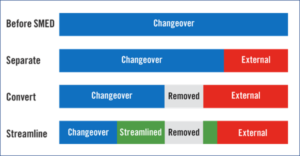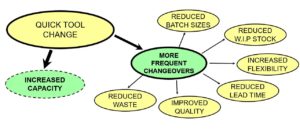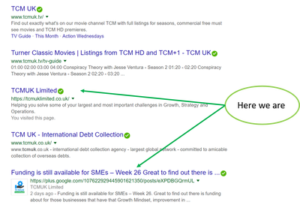Benefits of SMED (Single minute exchange of dies)
- WIP and lot size reduction.
- Finished goods inventory reduction.
- Improved machine/resource utilisation.
Whether you are high volume or low volume business, changeovers is one of those things that can sap the living life out of your manufacturing process.
An unstructured/wasteful approach to changeovers (SMED, set-up, etc) has the uncanny ability to grow arms and legs, and those arms and legs can even grow arms and legs.
I first witnessed a set up reduction back in the early 90’s as a Kaizen Engineer manufacturing Aerospace Fasteners, we were being trained by a Japanese sensei in Lean Manufacturing, running three events on different machines; a centreless grinder; a header machine and thread roller.
Our team had the header machine, we videoed the actual set up so we could observe the waste within the process, much to our surprise there was 8 hours of it????? A WHOLE SHIFT WORTH OF CHANGEOVER for a production run that would probably last no more than 30/60mins depending on batch size, and batch size we were talking thousands. It was running three shifts.
Now bearing in mind, a major customer had flagged this as an high risk to their operation due to capacity and were forcing discussions on us purchasing another machine?????
At the start of the week, we we’re thinking a 50% reduction would be excellent, never in a million years did we think we’d get to sub 30mins, but we did!
Long Changeovers drive so much waste within your business, WIP, Overproduction, delays, waiting, transportation…..so they need to be focussed on.
The main benefits are as shown
Key Principle of SMED
INTERNAL SET UP
Internal set up activities can only be performed when the process is stopped and must be kept to the absolute minimum in number and time taken to complete. Internal set-up activities should be limited to the actual fitting or removing of the Tool or Die or Material ONLY.
EXTERNAL SET UP
External set up activity can be performed with the process running and therefor does not affect the core changeover time.
As many changeover activities as possible should be external, leaving as few as possible as internal activities.
The statement that always sticks in my mind from my early SMED activities is ELIMINATE, COMBINE, SIMPLIFY.












